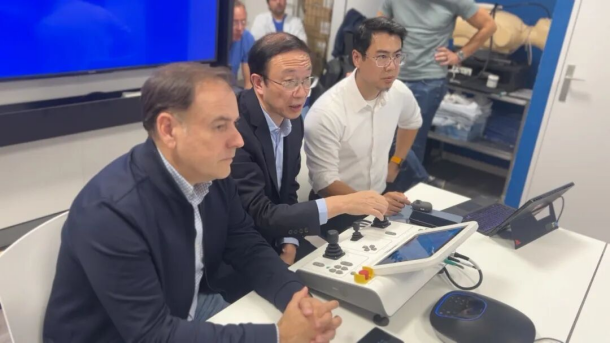“Made-in-China” Robot Performs Cross-Continental Heart Intervention, Achieving a World First in Remote Operations
03 November,2025
An Operation across Ten Thousand Miles
On October 23, a landmark medical operation was successfully completed at Xiamen Cardiovascular Hospital Xiamen University (hereinafter referred to as “XMCH”). The hospital performed the world’s first cross-national, robot-assisted transcatheter cardiac intervention, marking a new era of intelligent and globally collaborative cardiovascular treatment.
During the operation, Professor Wang Yan , President of XMCH, operated from Bordeaux University Hospital (CHU de Bordeaux) in France alongside Professor Lionel Leroux, head of the Adult Structural Heart Disease Intervention Department at Bordeaux University Hospital (CHU de Bordeaux). Professor Thomas Modine, Director of the Structural Valve Disease Treatment and Innovation Center at Bordeaux University Hospital (CHU de Bordeaux), participated remotely to provide real-time guidance. Through a remote control platform, the experts jointly operated a robotic system located in the catheterization lab in Xiamen, successfully completing a robot-assisted transcatheter edge-to-edge mitral valve repair (M-TEER).
The operation spanned the Eurasian continent, covering a communication distance of over 10,000 kilometers, enabling real-time, synchronized precision control between experts from both countries. According to available literature and authoritative reports, no prior clinical precedent of a cross-border, robot-assisted transcatheter cardiac intervention has been documented, making this operation a world first.

China-France Synchronization — Establishing a Model for Cross-National Robotic Operations
The procedure took place simultaneously in France and China. In Bordeaux, Professors Wang and Leroux accessed the robotic operation system in Xiamen via a high-speed, low-latency international network, performing precise navigation and remote manipulation of the mitral valve lesion. In XMCH’s catheterization lab, the robot—without any local operator—executed delicate tasks such as valve positioning and clipping on a beating heart. Every micromovement of the guidewire and clip precisely matched the commands from the French team in real time.
The XMCH cardiac intervention, anesthesia, ultrasound, and nursing teams continuously monitored the patient’s vital signs and system performance, ensuring stable signals, clear imaging, and procedural safety throughout.

The operation lasted for about one hour, maintaining a stable cross-continental signal and achieving sub-millimeter precision. The patient’s recovery was excellent, with near-zero residual mitral regurgitation, and has since been discharged in good condition.
Through real-time collaboration across ten thousand miles, the Chinese and French teams accomplished a highly complex intervention with exceptional precision. This achievement represents a major milestone in structural heart disease robotics, validating the feasibility and safety of remote precision control in real-world clinical practice. It lays a solid foundation for the future normalization of remote interventional procedure worldwide.

Technological Innovation Drives “China's Intelligent Manufacturing” on to the Global Stage
Independently Developed, Precisely Controlled
The robotic transcatheter cardiac intervention system used in this operation was jointly developed by XMCH and Shanghai Surgipulse Medical Technology Co., Ltd., through a medical-engineering collaboration. The system, fully protected by independent intellectual property rights, integrates high-precision robotic arms, intelligent motion control, high-reliability adaptive safety algorithms, and 5G-based redundant high-speed communication. Together, these technologies enable stable, low-latency, and highly visualized remote precision operations.
Overcoming Challenges, Entering a New Era
Performing valve repair on a beating heart is widely regarded as one of the most challenging procedures in cardiovascular intervention. Each heartbeat alters the heart’s anatomy, demanding exceptional spatial awareness, reaction speed, and hand-eye coordination from the operator — long-standing challenges in robotic-assisted cardiac operations worldwide.
The success of this operation signifies that medical robotics has advanced from “precision manipulation” to “cross-regional medical collaboration.” It demonstrates China’s innovation capacity in high-end medical equipment and showcases the success of “medical-engineering integration + international cooperation.”
Professional Excellence Beyond Borders
Following the procedure, Professor Thomas Modine commented:“This is an inspiring international collaboration and a milestone in medical history. The XMCH team demonstrated outstanding professionalism and innovation. Cross-border robotic procedures not only transcends geographical limitations but also sets a new benchmark for global medical cooperation.”
China’s Solution for Remote Medicine — From “Xiamen Innovation” to “Global Sharing”
As a National Regional Medical Center for Cardiovascular Diseases and a branch of the National Clinical Research Center for Cardiovascular Diseases, XMCH has long been committed to advancing an integrated system of “medical-engineering innovation.” Since performing the world’s first robot-assisted mitral valve repair using this system in 2023, the hospital has completed over 20 clinical applications. This latest achievement once again sets a world record, reinforcing China’s leadership in remote medicine and intelligent operations.
Professor Wang stated:
“Completing this procedure alongside our domestic team while in France marks an important step toward the globalization of Chinese medical technology. We have proven that a China-developed cardiovascular robotic system is capable of undertaking complex surgical tasks on the international stage.”
Looking ahead, remote robotic operations are expected to become a routine medical model, deeply integrated with artificial intelligence, big data, and smart planning to enable personalized treatment and global collaborative care—offering patients more precise, efficient, and accessible healthcare services.
share
Latest News
-
01 December,2025
Heart Saplings Blossom| Fellows from India and Indonesia Win Awards at International Academic Conferences with Cases from XMCH
-
03 November,2025
“Made-in-China” Robot Performs Cross-Continental Heart Intervention, Achieving a World First in Remote Operations
-
09 October,2025
Accelerating Technology Export | Xiamen experts conduct academic exchanges and demonstrate domestic IVL procedure in multiple hospitals in Pakistan

